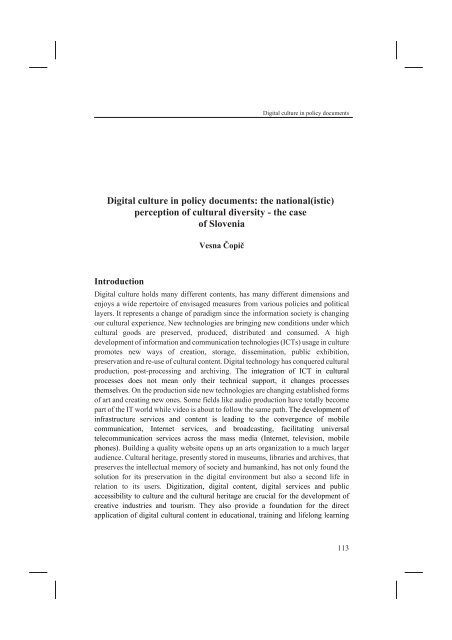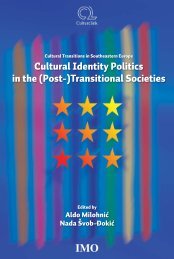D:\Documents and Settings\Ana\My Documents\Biserka-knjiga ...
D:\Documents and Settings\Ana\My Documents\Biserka-knjiga ...
D:\Documents and Settings\Ana\My Documents\Biserka-knjiga ...
Create successful ePaper yourself
Turn your PDF publications into a flip-book with our unique Google optimized e-Paper software.
Digital culture in policy documents: the national(istic)<br />
perception of cultural diversity - the case<br />
of Slovenia<br />
Introduction<br />
Vesna Èopiè<br />
Digital culture in policy documents<br />
Digital culture holds many different contents, has many different dimensions <strong>and</strong><br />
enjoys a wide repertoire of envisaged measures from various policies <strong>and</strong> political<br />
layers. It represents a change of paradigm since the information society is changing<br />
our cultural experience. New technologies are bringing new conditions under which<br />
cultural goods are preserved, produced, distributed <strong>and</strong> consumed. A high<br />
development of information <strong>and</strong> communication technologies (ICTs) usage in culture<br />
promotes new ways of creation, storage, dissemination, public exhibition,<br />
preservation <strong>and</strong> re-use of cultural content. Digital technology has conquered cultural<br />
production, post-processing <strong>and</strong> archiving. The integration of ICT in cultural<br />
processes does not mean only their technical support, it changes processes<br />
themselves. On the production side new technologies are changing established forms<br />
of art <strong>and</strong> creating new ones. Some fields like audio production have totally become<br />
part of the IT world while video is about to follow the same path. The development of<br />
infrastructure services <strong>and</strong> content is leading to the convergence of mobile<br />
communication, Internet services, <strong>and</strong> broadcasting, facilitating universal<br />
telecommunication services across the mass media (Internet, television, mobile<br />
phones). Building a quality website opens up an arts organization to a much larger<br />
audience. Cultural heritage, presently stored in museums, libraries <strong>and</strong> archives, that<br />
preserves the intellectual memory of society <strong>and</strong> humankind, has not only found the<br />
solution for its preservation in the digital environment but also a second life in<br />
relation to its users. Digitization, digital content, digital services <strong>and</strong> public<br />
accessibility to culture <strong>and</strong> the cultural heritage are crucial for the development of<br />
creative industries <strong>and</strong> tourism. They also provide a foundation for the direct<br />
application of digital cultural content in educational, training <strong>and</strong> lifelong learning<br />
113



